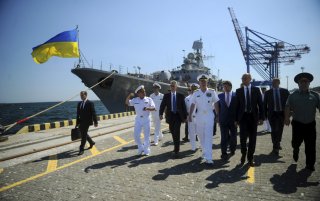The Ukrainian Navy Scuttled Its Flagship to Prevent Its Capture
It couldn't have done much to stop the Russian invasion on its own, but it would have been a major propaganda win for Russia had it been captured.
On the first day of the Russian invasion two weeks ago, the Ukrainian Navy made the drastic decision to scuttle its flagship, the Krivak III-class frigate Hetman Sahaidachny, to keep the vessel from falling into Russian hands. The thirty-year-old warship is now half-submerged in the port of Mykolaiv, where she had been undergoing repairs.
"The commander ordered to flood the ship so that the Hetman Sahaidachny frigate, which was under repair, did not reach the enemy," Oleksii Reznikov, Ukraine’s defence minister, said in a statement.
"It's hard to imagine a more difficult decision for a brave warrior and the entire team," Reznikov added. "But, we're building a new modern and powerful fleet. The main thing now is to stand up."
Scuttling the flagship was reportedly a difficult decision for the Ukrainian commanders to make, but they couldn't risk Russian forces taking control of it. The warship likely couldn't have done much to stop the Russian invasion on its own, but it would have been a major propaganda win for Russia had it been captured.
A Former Soviet Vessel
Construction of the frigate began in 1991, the final year that the Soviet Union was still in existence, and she was originally intended to be used by the Soviet Border Troops. Construction of the vessel was briefly halted with the dissolution of the Soviet Union, but she was completed in July 1993 and named after Petro Konshevych-Sahaidachny, a seventeenth century Ukrainian political and civic leader.
As the flagship of the Ukrainian Navy, she took part in the fiftieth anniversary of the invasion of Normandy in June 1994. The Hetman Sahaidachny even made port visits to Russia before relations between Russia and Ukraine deteriorated. She took part in NATO's "Operation Ocean Shield" anti-piracy campaign off the Horn of Africa in 2013.
The Ukrainian Navy's flagship was refueling in Greece when Russian forces seized control of Crimea in early January 2014. Russian state-run media claimed that the ship's crew defected to Russia and even raised the Russian flag, joining Ukraine's top naval officer, Vice Admiral Sergei Stanislavovich Yeliseyev, who defected to Russia in March of 2014. However, as the crew didn't actually defect, the Hetman Sahaidachny arrived in Odessa under the Ukrainian flag in the spring of 2014.
While the Ukrainian Navy had once been the pride of the nation's armed forces, it was greatly impacted by Russia's annexation of Crimea. Moscow essentially stole most of Ukraine's navy, and up to 75 percent of personnel abandoned their posts or defected to Russia.
Peter Suciu is a Michigan-based writer who has contributed to more than four dozen magazines, newspapers and websites. He regularly writes about military small arms, and is the author of several books on military headgear including A Gallery of Military Headdress, which is available on Amazon.com.
Image: Reuters.

